When you’re pitched up on tour, an important aspect of an enjoyable getaway will be having a working motorhome fridge, whether it’s for a chilled drink or keeping your perishables cool.
However, it can take a little bit of know-how to ensure you’re keeping your Chardonnay chilled and your fishfingers frozen while you’re on tour.
One thing we will highlight is that built-in, under-counter fridges can be a bit too small for a family of four or more, so keeping one of the best cool boxes for a campervan in the cab or in an awning is a great way to expand your cold-storage capacity when needed.
Here, I’m talking you through how you can prepare your motorhome’s fridge, explaining why you need to keep it level, and sharing my top tips for keeping it operating efficiently.
Preparing your motorhome fridge for touring
The majority of motorhome fridges nowadays operate on absorption technology – this will mean they have no moving parts and provide reliable cooling. However, owners of small campervans will most likely find they have a compressor fridge.
Absorption fridges are able to operate on either gas, 230V mains electricity from electric hook-up, or even 12V from your vehicle’s engine when you’re on the road. This final option can be particularly useful, as it means you reach your campsite with the fridge chilled, and then, after pitching up, the system can switch to either mains or gas; after all, the average leisure battery is only able to run a fridge for a few hours at the most.
If you do own an absorption fridge, make sure it’s working in all three modes before you leave, just so you don’t find after a long drive that any of the fridge’s contents have gone off.
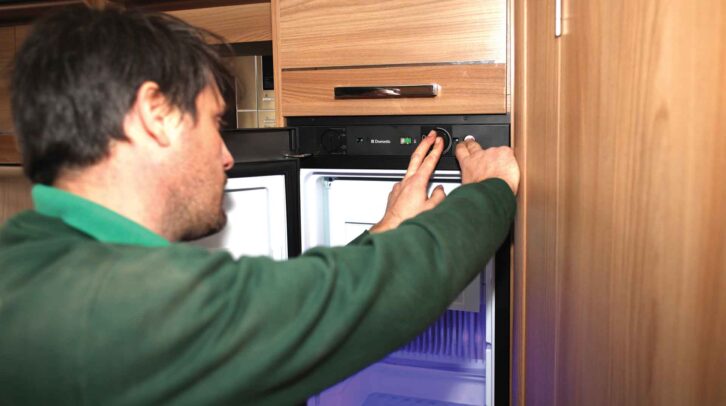
This type of fridge is great for keeping food cool, but one thing you need to ensure is that they have the appropriate power source for the conditions to have them running properly.
This is why it’s worth carrying out a quick and easy test before you set off, so you’re not confronted by food that has gone off when you arrive at your campsite – hardly the ideal start to what should be a relaxing getaway.
Something that canny motorhomers will do is cool the fridge the day before they set off, with the motorhome plugged in at home. Ice-packs can speed up the process here, while filling it with some chilled goods that will not deteriorate quickly can also help, although care should be taken to avoid overfilling it.
Keeping your fridge cool isn’t just about being able to have a cold drink when you want one, though – failing to keep it at the correct temperature can rapidly make your holiday transform into a nightmare. Warm food will be a breeding ground for Listeria monocytogenes, the bacteria behind listeriosis, which can cause symptoms including fever, sickness and diarrhoea.
Do motorhome fridges need to be level?
Yes, knowing how to level a motorhome will play a part in keeping your motorhome fridge working effectively. Simply put, you should have your fridge level to ensure everything is working as it should.
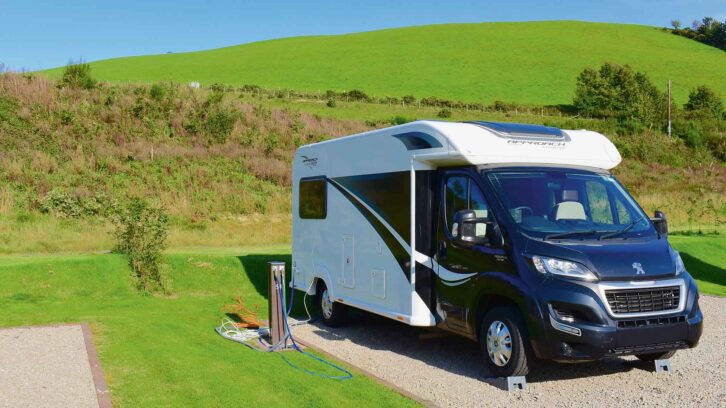
This is because the gas will move to a heat exchanger, transferring heat outside and then condensing back into liquid. However, this is a process which relies on gravity, so if it’s not level, the fridge will not be able to function efficiently. A good reason to have the best motorhome levelling ramps packed!
My top tips for keeping your motorhome fridge cold
- Nowadays, motorhome fridges will be able to operate effectively, even in hot conditions. I’m speaking from experience here – when touring to France in 42°C heat, the Thetford fridge in our Adria was running from mains hook-up and worked perfectly.
- Fridges will work at their best on 230V mains electricity and then gas, with 12V providing the least effective performance. If you’re planning on heading off-grid, I’d advise using gas.
- If the fridge hasn’t been used on gas for a while and you’re firing it up, you may become aware of a slight burning smell – this is normal. I’d recommend you run the fridge on gas for an hour or so, from time to time.
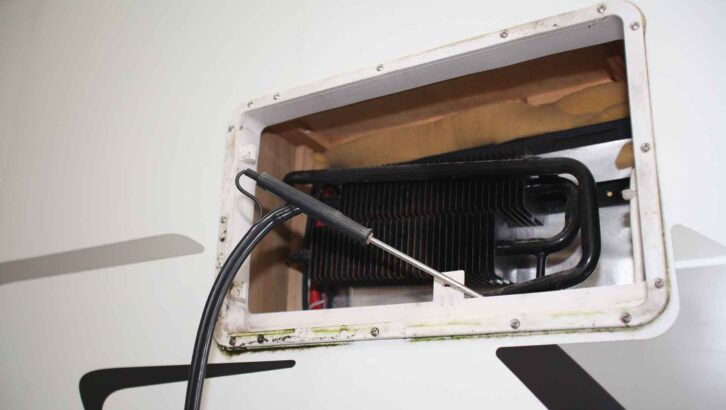
- When you have the motorhome on your drive, use an extension cable to achieve effective 230V mains cooling – if you’re away from power, opt for gas.
- When you’re loading a motorhome, you do so with care – do the same with your fridge. Make sure there is room for airflow around the food, and don’t cram it, to avoid having provisions touching the back, inner wall.
- The bottom shelves in the fridge will be the coldest, while the top shelves will maintain the most stable temperature.
- Something else to consider is pre-freezing items such as bread and milk before you put them in the fridge – this not only keeps them fresher for longer, but lowers the fridge temperature too. Putting chilled drinks in can also help the fridge get cooler faster.
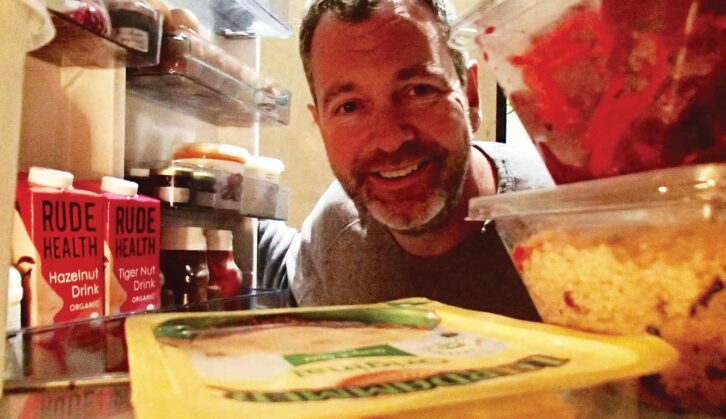
- If you’re embarking on a short ferry crossing, the good news is that a fridge will remain cool for hours if it’s left unopened. However, if you’re embarking on a longer crossing, it’s worth buying fresh food when you’ve disembarked and reached your destination.
- The temperature you should be setting the fridge at for optimal food safety is 1-4°C, making sure you have the door closed properly too – when the seals meet, it will suction in slightly.
- After a tour, you should always empty the fridge and clean it with a warm water and bicarbonate of soda solution. If you find there are persistent odours, leave half an onion in the fridge to absorb them.
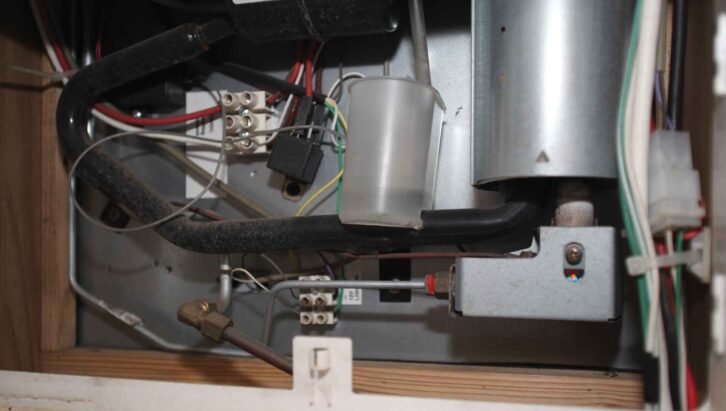
- When you’re not using the fridge, leave the door slightly open to allow airflow – you will find the majority of models will have door catches specifically for this.
- You will find the freezer box will freeze the most efficiently when it’s full up. Certain models will have an ice box that is removable, so if you don’t need to use it, you get extra space in the fridge.
- Store non-perishables out of the fridge and then cool them as you need to.
- Remember that certain fruits and vegetables, including avocados and tomatoes, will produce ethylene gas – this will result in any nearby produce ripening too quickly.
- If you take dry grains away with you, such as quinoa or lentils, these will store well if they are kept in the freezer compartment.
- If you’re storing hard-stalk herbs, you can keep them fresher in the fridge by wrapping them in a damp paper towel inside a resealable bag. In contrast, soft-stalk herbs are better kept in a jar with an inch of water, loosely covered with a plastic bag.
- Don’t keep potatoes, onions, tomatoes, berries, melons, bananas or olive oil (which will solidify) in the fridge, unless you want to chill them immediately before consuming them.
- A motorhome fridge should have been operated on gas for an hour during its PDI check, with a thorough fridge inspection a crucial part of your annual motorhome servicing regime.
A fridge is just one aspect of what you can expect to find in a ‘van’s kitchen, with the cooking appliances another important part. If you’re wondering what you can use to rustle up a meal in your ‘van, our guide to “can you use a microwave in a campervan?” is sure to help
Future Publishing Limited, the publisher of Practical Motorhome, provides the information in this article in good faith and makes no representation as to its completeness or accuracy. Individuals carrying out the instructions do so at their own risk and must exercise their independent judgement in determining the appropriateness of the advice to their circumstances. Individuals should take appropriate safety precautions and be aware of the risk of electrocution when dealing with electrical products. To the fullest extent permitted by law, neither Future nor its employees or agents shall have any liability in connection with the use of this information. Double check any warranty is not affected before proceeding.
If you’ve enjoyed reading this article, why not get the latest news, reviews and features delivered direct to your door or inbox every month. Take advantage of our brilliant Practical Motorhome magazine SUBSCRIBERS’ OFFER and SIGN UP TO OUR NEWSLETTER for regular weekly updates on all things motorhome related.
Leave a Reply